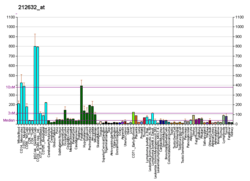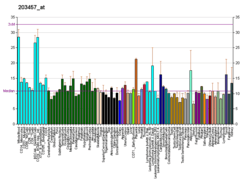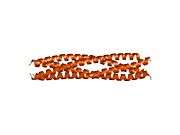STX7
Syntaxin-7 is a protein that in humans is encoded by the STX7 gene.[5][6]
In melanocytic cells STX7 gene expression may be regulated by MITF.[7]
Interactions
STX7 has been shown to interact with STX8,[8] VPS18,[9] Vesicle-associated membrane protein 8[8][10] and VPS11.[9]
gollark: ++delete cyan (the color)
gollark: ++delete staplers
gollark: My neck doesn't have a hole or whatever big enough for a stapler to go through it. I don't know anyone with a neck like that.
gollark: What?
gollark: The Soviet national anthem is not mere "music".
References
- GRCh38: Ensembl release 89: ENSG00000079950 - Ensembl, May 2017
- GRCm38: Ensembl release 89: ENSMUSG00000019998 - Ensembl, May 2017
- "Human PubMed Reference:". National Center for Biotechnology Information, U.S. National Library of Medicine.
- "Mouse PubMed Reference:". National Center for Biotechnology Information, U.S. National Library of Medicine.
- Wang H, Frelin L, Pevsner J (October 1997). "Human syntaxin 7: a Pep12p/Vps6p homologue implicated in vesicle trafficking to lysosomes". Gene. 199 (1–2): 39–48. doi:10.1016/S0378-1119(97)00343-0. PMID 9358037.
- "Entrez Gene: STX7 syntaxin 7".
- Hoek KS, Schlegel NC, Eichhoff OM, Widmer DS, Praetorius C, Einarsson SO, Valgeirsdottir S, Bergsteinsdottir K, Schepsky A, Dummer R, Steingrimsson E (December 2008). "Novel MITF targets identified using a two-step DNA microarray strategy". Pigment Cell & Melanoma Research. 21 (6): 665–76. doi:10.1111/j.1755-148X.2008.00505.x. PMID 19067971.
- Antonin W, Holroyd C, Fasshauer D, Pabst S, Von Mollard GF, Jahn R (December 2000). "A SNARE complex mediating fusion of late endosomes defines conserved properties of SNARE structure and function". The EMBO Journal. 19 (23): 6453–64. doi:10.1093/emboj/19.23.6453. PMC 305878. PMID 11101518.
- Kim BY, Krämer H, Yamamoto A, Kominami E, Kohsaka S, Akazawa C (August 2001). "Molecular characterization of mammalian homologues of class C Vps proteins that interact with syntaxin-7". The Journal of Biological Chemistry. 276 (31): 29393–402. doi:10.1074/jbc.M101778200. PMID 11382755.
- Wade N, Bryant NJ, Connolly LM, Simpson RJ, Luzio JP, Piper RC, James DE (June 2001). "Syntaxin 7 complexes with mouse Vps10p tail interactor 1b, syntaxin 6, vesicle-associated membrane protein (VAMP)8, and VAMP7 in b16 melanoma cells". The Journal of Biological Chemistry. 276 (23): 19820–7. doi:10.1074/jbc.M010838200. PMID 11278762.
Further reading
- Wong SH, Xu Y, Zhang T, Hong W (January 1998). "Syntaxin 7, a novel syntaxin member associated with the early endosomal compartment". The Journal of Biological Chemistry. 273 (1): 375–80. doi:10.1074/jbc.273.1.375. PMID 9417091.
- Steegmaier M, Yang B, Yoo JS, Huang B, Shen M, Yu S, Luo Y, Scheller RH (December 1998). "Three novel proteins of the syntaxin/SNAP-25 family". The Journal of Biological Chemistry. 273 (51): 34171–9. doi:10.1074/jbc.273.51.34171. PMID 9852078.
- Prekeris R, Yang B, Oorschot V, Klumperman J, Scheller RH (November 1999). "Differential roles of syntaxin 7 and syntaxin 8 in endosomal trafficking". Molecular Biology of the Cell. 10 (11): 3891–908. doi:10.1091/mbc.10.11.3891. PMC 25687. PMID 10564279.
- Nakamura N, Yamamoto A, Wada Y, Futai M (March 2000). "Syntaxin 7 mediates endocytic trafficking to late endosomes". The Journal of Biological Chemistry. 275 (9): 6523–9. doi:10.1074/jbc.275.9.6523. PMID 10692457.
- Scales SJ, Chen YA, Yoo BY, Patel SM, Doung YC, Scheller RH (May 2000). "SNAREs contribute to the specificity of membrane fusion". Neuron. 26 (2): 457–64. doi:10.1016/S0896-6273(00)81177-0. PMID 10839363.
- Mullock BM, Smith CW, Ihrke G, Bright NA, Lindsay M, Parkinson EJ, Brooks DA, Parton RG, James DE, Luzio JP, Piper RC (September 2000). "Syntaxin 7 is localized to late endosome compartments, associates with Vamp 8, and Is required for late endosome-lysosome fusion". Molecular Biology of the Cell. 11 (9): 3137–53. doi:10.1091/mbc.11.9.3137. PMC 14981. PMID 10982406.
- Antonin W, Holroyd C, Fasshauer D, Pabst S, Von Mollard GF, Jahn R (December 2000). "A SNARE complex mediating fusion of late endosomes defines conserved properties of SNARE structure and function". The EMBO Journal. 19 (23): 6453–64. doi:10.1093/emboj/19.23.6453. PMC 305878. PMID 11101518.
- Wade N, Bryant NJ, Connolly LM, Simpson RJ, Luzio JP, Piper RC, James DE (June 2001). "Syntaxin 7 complexes with mouse Vps10p tail interactor 1b, syntaxin 6, vesicle-associated membrane protein (VAMP)8, and VAMP7 in b16 melanoma cells". The Journal of Biological Chemistry. 276 (23): 19820–7. doi:10.1074/jbc.M010838200. PMID 11278762.
- Kim BY, Krämer H, Yamamoto A, Kominami E, Kohsaka S, Akazawa C (August 2001). "Molecular characterization of mammalian homologues of class C Vps proteins that interact with syntaxin-7". The Journal of Biological Chemistry. 276 (31): 29393–402. doi:10.1074/jbc.M101778200. PMID 11382755.
- Rotem-Yehudar R, Galperin E, Horowitz M (August 2001). "Association of insulin-like growth factor 1 receptor with EHD1 and SNAP29". The Journal of Biological Chemistry. 276 (35): 33054–60. doi:10.1074/jbc.M009913200. PMID 11423532.
- Suzuki H, Fukunishi Y, Kagawa I, Saito R, Oda H, Endo T, Kondo S, Bono H, Okazaki Y, Hayashizaki Y (October 2001). "Protein-protein interaction panel using mouse full-length cDNAs". Genome Research. 11 (10): 1758–65. doi:10.1101/gr.180101. PMC 311163. PMID 11591653.
- Antonin W, Fasshauer D, Becker S, Jahn R, Schneider TR (February 2002). "Crystal structure of the endosomal SNARE complex reveals common structural principles of all SNAREs". Nature Structural Biology. 9 (2): 107–11. doi:10.1038/nsb746. hdl:11858/00-001M-0000-0012-F459-F. PMID 11786915.
- Antonin W, Dulubova I, Arac D, Pabst S, Plitzner J, Rizo J, Jahn R (September 2002). "The N-terminal domains of syntaxin 7 and vti1b form three-helix bundles that differ in their ability to regulate SNARE complex assembly". The Journal of Biological Chemistry. 277 (39): 36449–56. doi:10.1074/jbc.M204369200. PMID 12114520.
- Bogdanovic A, Bennett N, Kieffer S, Louwagie M, Morio T, Garin J, Satre M, Bruckert F (November 2002). "Syntaxin 7, syntaxin 8, Vti1 and VAMP7 (vesicle-associated membrane protein 7) form an active SNARE complex for early macropinocytic compartment fusion in Dictyostelium discoideum". The Biochemical Journal. 368 (Pt 1): 29–39. doi:10.1042/BJ20020845. PMC 1222979. PMID 12175335.
- Collins RF, Schreiber AD, Grinstein S, Trimble WS (September 2002). "Syntaxins 13 and 7 function at distinct steps during phagocytosis". Journal of Immunology. 169 (6): 3250–6. doi:10.4049/jimmunol.169.6.3250. PMID 12218144.
- Adkins JN, Varnum SM, Auberry KJ, Moore RJ, Angell NH, Smith RD, Springer DL, Pounds JG (December 2002). "Toward a human blood serum proteome: analysis by multidimensional separation coupled with mass spectrometry". Molecular & Cellular Proteomics. 1 (12): 947–55. doi:10.1074/mcp.M200066-MCP200. PMID 12543931.
- Gevaert K, Goethals M, Martens L, Van Damme J, Staes A, Thomas GR, Vandekerckhove J (May 2003). "Exploring proteomes and analyzing protein processing by mass spectrometric identification of sorted N-terminal peptides". Nature Biotechnology. 21 (5): 566–9. doi:10.1038/nbt810. PMID 12665801.
- Suzuki J, Ohnishi H, Wada A, Hirayama T, Ohno H, Ueda N, Yasuda H, Iiri T, Wada Y, Futai M, Mashima H (July 2003). "Involvement of syntaxin 7 in human gastric epithelial cell vacuolation induced by the Helicobacter pylori-produced cytotoxin VacA". The Journal of Biological Chemistry. 278 (28): 25585–90. doi:10.1074/jbc.M212445200. PMID 12730232.
This article is issued from Wikipedia. The text is licensed under Creative Commons - Attribution - Sharealike. Additional terms may apply for the media files.








